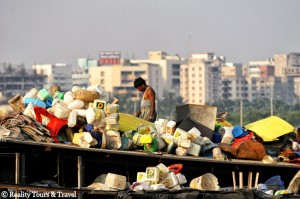Shitty Justice: Environmental Injustice in India —Part I
In January 2013, I along with five colleagues from Connecticut College traveled to India for “Global Environmental Justice” field trip. A semester long seminar of the same name preceded this trip and in a way shaped it as well. Our three field sites included Delhi, Pune, and Bombay. In Delhi, we visited ToxicLinks, an NGO working for “environmental justice and freedom from toxics;” in Pune we visited Shelter Associates, an NGO working on sanitation issues, especially providing toilets to women in slum dwellings. In Bombay, we became “slum tourists” when we toured Dharavi (the largest slum dwelling in Asia and of “Slumdog Millionaire” fame). All visits were unforgettable in that the empirical reality of global environmental (in) justice is stark and emotionally moving. Reading books and watching documentaries on environmental injustice in no way prepares you for the visual and olfactory blast when you are physically there. My world was turned upside down and stretched to a breaking point when I saw how an “underprivileged” humanity lives and performs this injustice on a daily basis. I retreated into a self-reflexive space when I came back home, asking myself a set of difficult questions—sometimes finding no answers, only more questions. I share here my self-tussle—its raw, emotional immediacy for this contains clues to how I might think about being and doing in the “field.”
in Pune we visited Shelter Associates, an NGO working on sanitation issues, especially providing toilets to women in slum dwellings. In Bombay, we became “slum tourists” when we toured Dharavi (the largest slum dwelling in Asia and of “Slumdog Millionaire” fame). All visits were unforgettable in that the empirical reality of global environmental (in) justice is stark and emotionally moving. Reading books and watching documentaries on environmental injustice in no way prepares you for the visual and olfactory blast when you are physically there. My world was turned upside down and stretched to a breaking point when I saw how an “underprivileged” humanity lives and performs this injustice on a daily basis. I retreated into a self-reflexive space when I came back home, asking myself a set of difficult questions—sometimes finding no answers, only more questions. I share here my self-tussle—its raw, emotional immediacy for this contains clues to how I might think about being and doing in the “field.”
I want to describe the following text as an “interrogative text” because it asks more questions than it has answers to. And the reason for asking too many questions is to emphasize, according to Catherine Belsey, “the subject split into both subject and object; as continually in the process of construction, or a subject in process” (1980: 90). In doing so, I am hoping to discourage the reader to identify with me as what Kamala Visweswaran calls a “unified subject of enunciation” (1994: 62). As you will see, I am “in” in the text but not the only one here. I switch back between “you and we,” both whose locations are left ambiguous to a larger degree. I am also the interrogating subject in this text—questioning everything about an experience and those experiencing situations with me. I am simultaneously a subject that inquires and the object that is inquired about in an endless trend of inquiring that ultimately leads to no (dis)closures. A closure (a consequence of disclosure), I suspect, would bring an expected end to a story. But this story has no end for injustice has no end, yet. So the story and the interrogations within must continue . . ..
Global Environmental Justice—what does it mean to me as a concept, more than an interactive space to discuss this concept? And why must I ask this question now on this field trip to India? Why didn’t I ask this question in the seminar at Connecticut College? I realize that I know so little about environmental justice in India. What constitutes the “environment” in India and its justice dimension, I am not read up on. However, instead of thinking about environment and justice in its broad national dimension, I want to think about environment as a personal, intimate space within which individuals inhabiting this space conduct certain practices. In other words, can the “home” be that personal space and therefore that environment within which parents and children conduct certain practices that help safeguard this environment? When a parent tells a child to finish their food, wash their plate, and clean their eating spot, is that parent transmitting an environmental practice? Cleanliness is an environmental practice in the context of home because it keeps those engaged in “clean” practices safe from all that is “unclean” and therefore potentially harmful. But does everyone in the context of home engage in such practices equally or does someone share an unequal burden of cleaning the environment, of safeguarding it? If women share this unequal burden even as they transfer clean practices to their children on a daily basis, then justice is an issue in this intimate space, isn’t it? But somehow justice in the context of the home seems too harsh and alien a word. If the home is presumably and in all domesticated imagination a safe place, then what is justice in this context? How do we talk about justice in this space and for whom?  Does environmental justice make sense in the context of home, in private spaces marked by the ideology of nurture and practices that promote such nurture in various degrees? If one dimension of “nurture/ing” is cleanliness in the bedroom, bathroom, kitchen in the context of home, what of outside of the home? What of the immediate spaces outside of the home that is private no more? Cleaning the private spaces means transferring the “unclean,” the excreta to some-place else. What is that someplace else? The space outside the boundary wall of the home? What happens when keeping the private clean means making the public unclean? What does it mean to think of the public space as non-space, owned by no one yet (ab) used by everyone as a dumping site of the unwanted? What does it mean then to see your own private shit in full public view? Do you even see it? I never saw my own private shit in public spaces even though I knew it was there. It was just how it was. It never bothered me in the way the same shit in my private space made me go ballistic. So my sense of the private in an environmental sense was far more developed than my sense of the public, the non-space, and the non-existent/ existent space. Shit in private spaces directly affected me and all those living with me. But shit in public space did not (apparently). A faint notion of justice existed in private space but none in the public space.
Does environmental justice make sense in the context of home, in private spaces marked by the ideology of nurture and practices that promote such nurture in various degrees? If one dimension of “nurture/ing” is cleanliness in the bedroom, bathroom, kitchen in the context of home, what of outside of the home? What of the immediate spaces outside of the home that is private no more? Cleaning the private spaces means transferring the “unclean,” the excreta to some-place else. What is that someplace else? The space outside the boundary wall of the home? What happens when keeping the private clean means making the public unclean? What does it mean to think of the public space as non-space, owned by no one yet (ab) used by everyone as a dumping site of the unwanted? What does it mean then to see your own private shit in full public view? Do you even see it? I never saw my own private shit in public spaces even though I knew it was there. It was just how it was. It never bothered me in the way the same shit in my private space made me go ballistic. So my sense of the private in an environmental sense was far more developed than my sense of the public, the non-space, and the non-existent/ existent space. Shit in private spaces directly affected me and all those living with me. But shit in public space did not (apparently). A faint notion of justice existed in private space but none in the public space.
If I were to extend this very restrictive notion of public space (immediate space outside the homestead boundary) and it being a non-space to becoming a space trafficked by people and animals who can see and who can smell, then what would justice look like now? I don’t know. I worked with an NGO in Delhi for three years way back in the 1990s. I developed a working curriculum for rural adult women and girls who had been denied access to education for various cultural and economic reasons. By working curriculum I mean a curriculum that developed alongside and addressed women’s articulated existential angst. It was not a preset curriculum assuming the education the women should have rather than what they needed. So if scarcity of water was a matter of supreme existential angst then the curriculum recognized it in the way it structured the lessons and classroom pedagogy. We didn’t give chemistry lessons in the formation of H20 rather we focused on the social and political dimensions of water (its distribution and consumption) because that is what contributed to the women’s angst.
 In developing this curriculum, I read and re-read books/ information I had previously read in middle school. I read about the history of ideas around environment in post-colonial India. I read about the Chipko movement and then I wrote lessons describing the brave women who led the tree-hugging movement to protect their forests from commercial felling. This the village women loved. It was empowering. It was real. It was too close to home. It generated possibilities of activism in their minds. It made clear the connections between an apathetic government, laws without teeth, powerful private lobbies for commercial felling, and people’s dependence on depleting forests for survival. So justice in this form of public space required some form of activism as drawn from connections between lives and politics; contemporary lives and colonial/ postcolonial politics. The chapter I wrote on the Chipko movement then became the template for women to organize with other local actors and create change in their local spaces. But even as these women were working to create their own activist spaces in their specific geographical locations their “justice” work must be juxtaposed with a prevailing idea of “environmental” justice as antithetical to development. For example, to be against building of dams was seen as anti-development and therefore anti-modernity. Environmentalists who attempted to connect development to anti-humanism were seen as misguided people subverting the project of a post-colonial state and even if one disagreed with such a position/ connection, it was not made into an object of inquiry. We did not make this into an object of inquiry. Making this into an object of inquiry meant making our own positionalities and locations into an object of inquiry as well. This meant giving others the permission to question our very presence in this public space of inquiry around environment and justice.
In developing this curriculum, I read and re-read books/ information I had previously read in middle school. I read about the history of ideas around environment in post-colonial India. I read about the Chipko movement and then I wrote lessons describing the brave women who led the tree-hugging movement to protect their forests from commercial felling. This the village women loved. It was empowering. It was real. It was too close to home. It generated possibilities of activism in their minds. It made clear the connections between an apathetic government, laws without teeth, powerful private lobbies for commercial felling, and people’s dependence on depleting forests for survival. So justice in this form of public space required some form of activism as drawn from connections between lives and politics; contemporary lives and colonial/ postcolonial politics. The chapter I wrote on the Chipko movement then became the template for women to organize with other local actors and create change in their local spaces. But even as these women were working to create their own activist spaces in their specific geographical locations their “justice” work must be juxtaposed with a prevailing idea of “environmental” justice as antithetical to development. For example, to be against building of dams was seen as anti-development and therefore anti-modernity. Environmentalists who attempted to connect development to anti-humanism were seen as misguided people subverting the project of a post-colonial state and even if one disagreed with such a position/ connection, it was not made into an object of inquiry. We did not make this into an object of inquiry. Making this into an object of inquiry meant making our own positionalities and locations into an object of inquiry as well. This meant giving others the permission to question our very presence in this public space of inquiry around environment and justice.
The Global Environment Justice (GEJ) seminar for faculty at Connecticut College seemed like an opportunity to reflect on “me” in that space at that time—to make myself and my histories, especially in and through my travels through familiar public and private spaces in India doing education, into an object of inquiry. GEJ was also convenient. It was an excuse to travel to and within India as an outsider (in the environment context) and insider (in the “home” context) and observe for myself how this hyphenated identity will play out in such travels. I didn’t expect to feel so much. While moving through radically different places/ spaces where this movement is not of your own choosing in that it is made at the behest of the other (an institution, a project); where your presence in these spaces is without a self-defined agenda (research or methodological); where your lens is foggy and you are forced to borrow a different lens, not necessarily better or worse but a “superior” white-rose colored lens. And it is not what you see or don’t see through this lens but what you see of you looking through it—the stack of privileges on which you now sit and even carry with you as you find easy access to awful and awe full spaces in the name of some unarticulated, even misplaced desire to understand and save others from themselves. In using this borrowed lens to see a “familiar” space can only create a fogginess and lead to frustrations around what you are seeing and the way in which you are seeing it—and without knowing the particular personal and professional reasons for this difficult process of seeing. I think the very act of crossing into spaces, marked by severe difference not only of class or caste or race to name just a few theorized differences but also of time, intention, action, attitude, body placements, distance, emotion, and so on, requires a particular kind of etiquette of crossing. This etiquette is defined by answering for your own self a set of questions about this crossing—impending or real—for what purpose and why? What does it mean to cross into, not to cross over but to cross back and return to one’s comfort zone or clean, sanitized spaces? What does it mean to be a slum tourist? What is the purpose of slum tourism? Is the purpose to see the grime and filth of a slum in order to prove to yourself that something that you read in books/ papers exists (Q.E.D)? Or is the purpose to be reminded of our own privilege and therefore be thankful for it (“thank god I have a return ticket”)? Or is the purpose to understand our own privilege as someone else’s lack of it, especially in the practice of our own apathy born largely of this privilege and the cultural practices that reinstitutionalize this privilege? What of our celebration of our privilege in this constant back and forth between dramatically different cultural spaces, access to which is guaranteed only by one’s position in the harems of privilege, transnationally? I think there is something infinitely terrible about slum tourism, more so than the slum itself. To survey people in their “naturalized” habitat with a disinterested eye while keeping pretenses (of interest) in their “sorry” state of existence, is a power play by the socially entitled (like professors from a foreign university). Slum tourism makes this power play possible, the ultimate affect of which is the redrawing the lines of separation between me and them.

When a slum, a “disgusting” space from a privilege standpoint is made into an object of admiration in and through tourism, it is rendered natural. It just must exist irrespective of how people within it barely do. Slum tourism then disrupts and dissipates the slum as a demonized space. It dresses it in t-shirts with pathetically smiley faces and hangs it up as grocery bags in far away homes of inconsequential people. It makes sweet smelling candles in its name so those inconsequential people can remove the stench of its rottenness. What does it mean to get groceries in a bag with Dharavi written across it, when Dharavi can neither afford these groceries nor the bag? Slum tourism renders the slum a demonized, exoticized, and marginalized space all at once.





0 comments